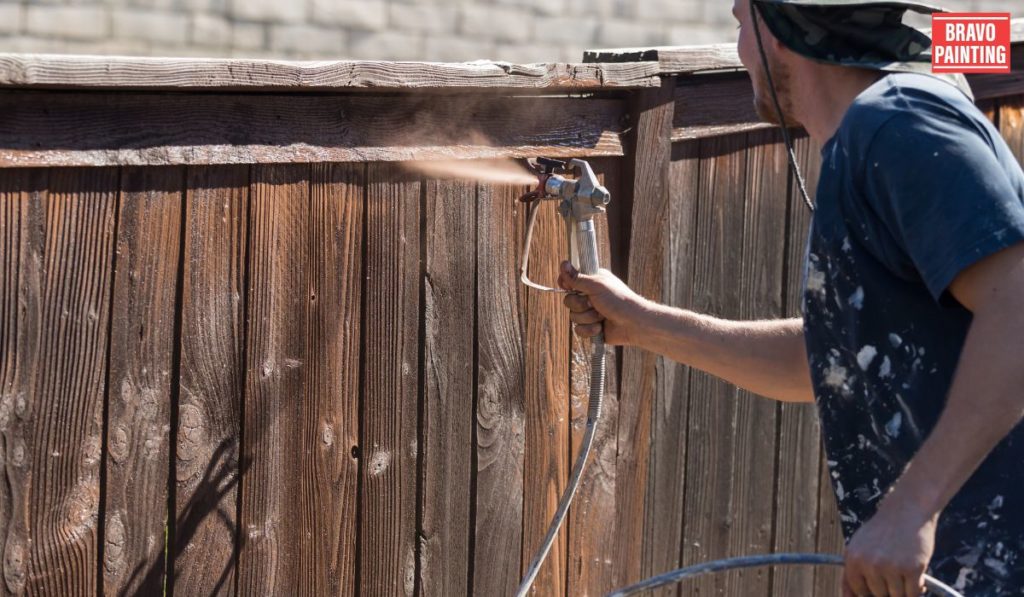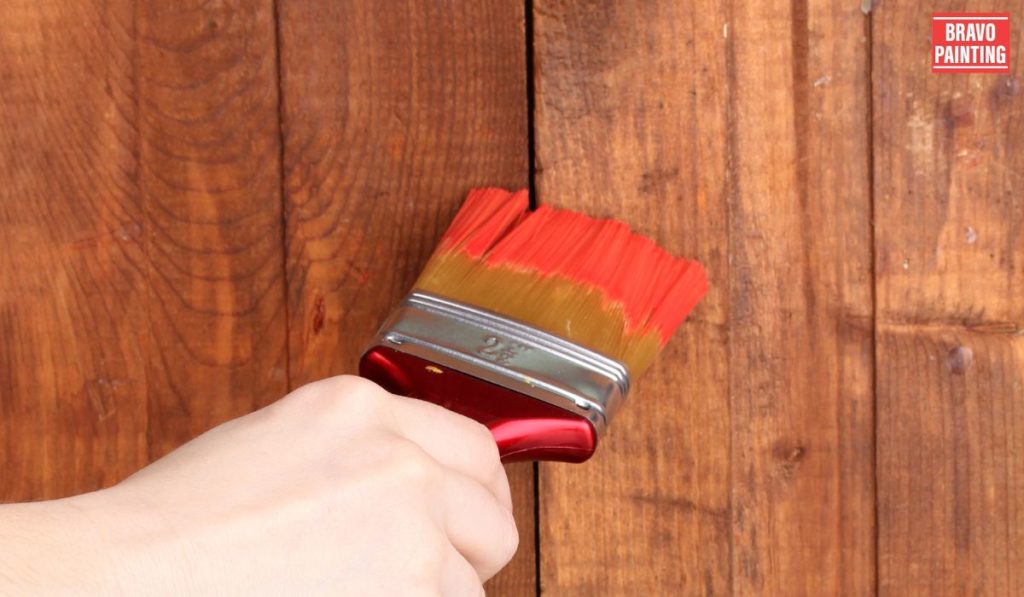When it comes to maintaining and enhancing the appearance of your fence, one crucial decision you’ll face is whether to paint or stain it.
Both options have advantages and considerations, so it’s critical to understand the differences and make an informed choice.
In this article, we’ll explore the factors to consider when deciding whether to paint & stain your fence.
Understanding the Difference
Before making a decision, it’s essential to understand the fundamental differences between painting and staining your fence:
Painting: Painting your fence involves applying a layer of paint that coats the surface and forms a protective barrier.
Paint provides a wide range of color options and can completely change the appearance of your fence.
It also protects against moisture, UV rays, and other weather elements.
However, paint can chip or peel over time, requiring periodic touch-ups or repainting.
Staining: Staining your fence involves applying a stain penetrating the wood and enhancing its natural color.
Dye is available in various shades and can add depth and richness to the wood grain.
Unlike paint, the stain doesn’t form a thick film on the surface but seeps into the wood, allowing it to breathe.
Color provides some protection against moisture and UV rays, but it may require more frequent reapplication compared to paint.

Factors to Consider
When deciding whether to paint your fence, consider the following factors:
Aesthetics: Think about the desired look for your fence.
Painting is better if you prefer a solid, opaque color covering the natural wood grain.
On the other hand, if you appreciate the natural beauty of the wood and want to enhance its appearance, staining is a suitable option.
Maintenance: Consider the level of care you’re willing to commit to.
Paint generally requires less frequent maintenance as it forms a more durable protective layer.
However, if the paint chips or peels, it can be more noticeable and may require more extensive touch-ups.
Stain, while providing a more natural look, typically requires reapplication every few years to maintain its appearance and protection.
Durability: Evaluate the durability needs of your fence.
If your wall is exposed to harsh weather conditions or high foot traffic, paint may offer better resistance to wear and tear.
Stain, on the other hand, maybe more susceptible to fading and may require additional protective coatings for long-term durability.
Longevity: Consider the desired lifespan of your fence.
Depending on various factors, paint generally provides a longer-lasting finish, lasting 5-10 years or more.
A stain may need to be reapplied every 2-5 years, depending on the quality of the color and exposure to the elements.
Personal Preference: Ultimately, your personal preference plays a significant role. Consider your taste, style, and the overall aesthetic of your property.
If you have a particular color scheme in mind or want to match the fence with the exterior of your home, painting allows for more customization.
Staining, on the other hand, preserves the natural beauty of the wood and may be preferred if you enjoy a more rustic or organic look.
Conclusion
The decision to paint or stain your fence depends on your specific preferences, maintenance expectations, and the desired look you want to achieve.
Consider factors such as aesthetics, maintenance, durability, longevity, and personal preference before making your final choice.
If you still need clarification, consult a professional fence contractor who can provide expert advice based on your situation.
Remember, whether you paint or stain your fence, regular maintenance & care are essential to keep it looking its best and ensure its long-term durability.
FAQs
How do I decide between painting and staining my fence?
The decision between painting and staining your fence depends on various factors, such as your aesthetic preferences, desired level of maintenance, durability needs, and the natural beauty of the wood. Consider these factors and carefully evaluate each option’s advantages and disadvantages to make a well-informed decision.
Which option provides better protection for my fence: paint or stain?
Both paint and stain offer some level of protection for your fence. Paint forms a thicker barrier against moisture and UV rays, providing enhanced security. Stain, conversely, penetrates the wood and allows it to breathe while offering some protection. The choice depends on your specific needs & your fence’s exposure to weather elements.
Will paint or stain last longer on my fence?
Paint generally has a longer lifespan compared to stain. Depending on various factors such as weather conditions, quality of the product, and maintenance, paint can last 5-10 years or more. Color typically requires reapplication every 2-5 years to maintain appearance and protection.
Can I change my decision later and switch from paint to stain or vice versa?
While it’s possible to switch from paint to stain or vice versa, it requires some preparation. You must remove the existing paint layer through stripping or sanding to change from color to tint. Similarly, switching from stain to paint may require sanding to remove the stain and prepare the surface for painting. Consult with professionals for the best approach.

Does paint or stain require more maintenance over time?
Paint generally requires less frequent maintenance as it forms a more durable protective layer. However, if the paint chips or peels, it can be more noticeable and may require touch-ups or repainting. Stain typically requires reapplication every few years to maintain its appearance and protection.
Can I paint or stain a previously painted or stained fence?
Yes, it’s possible to paint or stain a previously painted or stained fence. However, proper surface preparation is crucial. For paint, you may need to scrape off loose or peeling paint and sand the surface before applying a new coat. For stain, ensure the previous color is sufficiently weathered or remove it through stripping or sanding before applying fresh paint.
Can I achieve different colors with paint and stain?
Yes, both paint and stain offer a range of color options. Paint provides more versatility in color choices, allowing you to match your fence with the exterior of your home or achieve a specific color scheme. Stain enhances the native color of the wood and is available in various shades that can add richness and depth to the wood grain.
Will painting or staining affect the texture of the wood?
Paint forms a thicker layer on the surface of the wood, which can slightly obscure the natural texture. Stain, on the other hand, allows the texture and grain of the wood to show through as it penetrates the fibers. If you prefer the natural texture of the wood to be more visible, staining may be a better option.
Can I combine paint and stain on my fence for a unique look?
Combining paint and stain on your fence can achieve a unique look. For example, you can paint the main body of the wall and stain the top railings or certain sections for contrast. This can create a visually appealing and personalized design. Consult with professionals or explore creative ideas to find the combination that suits your style.
Can I apply paint or stain to a fence made of materials other than wood?
While paint and stain are commonly used for wooden fences, they may not be suitable for other materials such as vinyl, metal, or composite. These materials often have specific coatings or finishes to enhance their durability and appearance. Consult with professionals to determine the best options for non-wooden fence materials.



